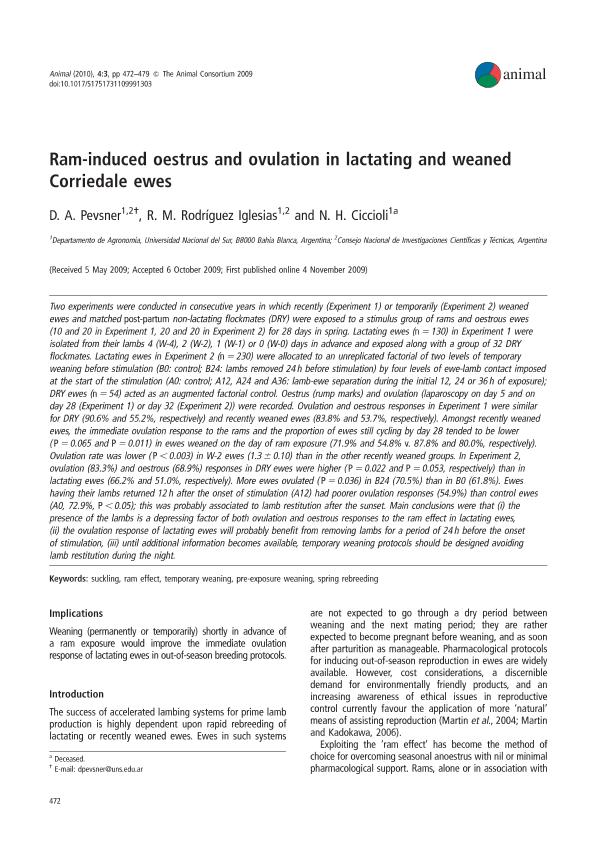Mostrar el registro sencillo del ítem
dc.contributor.author
Pevsner, Damián Andrés

dc.contributor.author
Rodríguez Iglesias, Ricardo Manuel

dc.contributor.author
Ciccioli, N.H.
dc.date.available
2018-10-10T17:26:53Z
dc.date.issued
2010-05
dc.identifier.citation
Pevsner, Damián Andrés; Rodríguez Iglesias, Ricardo Manuel; Ciccioli, N.H.; Ram-induced oestrus and ovulation in lactating and weaned Corriedale ewes; Cambridge University Press; Animal; 4; 3; 5-2010; 472-479
dc.identifier.issn
1751-7311
dc.identifier.uri
http://hdl.handle.net/11336/62083
dc.description.abstract
Two experiments were conducted in consecutive years in which recently (Experiment 1) or temporarily (Experiment 2) weaned ewes and matched post-partum non-lactating flockmates (DRY) were exposed to a stimulus group of rams and oestrous ewes (10 and 20 in Experiment 1, 20 and 20 in Experiment 2) for 28 days in spring. Lactating ewes (n = 130) in Experiment 1 were isolated from their lambs 4 (W-4), 2 (W-2), 1 (W-1) or 0 (W-0) days in advance and exposed along with a group of 32 DRY flockmates. Lactating ewes in Experiment 2 (n = 230) were allocated to an unreplicated factorial of two levels of temporary weaning before stimulation (B0: control; B24: lambs removed 24 h before stimulation) by four levels of ewe-lamb contact imposed at the start of the stimulation (A0: control; A12, A24 and A36: lamb-ewe separation during the initial 12, 24 or 36 h of exposure); DRY ewes (n = 54) acted as an augmented factorial control. Oestrus (rump marks) and ovulation (laparoscopy on day 5 and on day 28 (Experiment 1) or day 32 (Experiment 2)) were recorded. Ovulation and oestrous responses in Experiment 1 were similar for DRY (90.6% and 55.2%, respectively) and recently weaned ewes (83.8% and 53.7%, respectively). Amongst recently weaned ewes, the immediate ovulation response to the rams and the proportion of ewes still cycling by day 28 tended to be lower (P = 0.065 and P = 0.011) in ewes weaned on the day of ram exposure (71.9% and 54.8% v. 87.8% and 80.0%, respectively). Ovulation rate was lower (P < 0.003) in W-2 ewes (1.3 ± 0.10) than in the other recently weaned groups. In Experiment 2, ovulation (83.3%) and oestrous (68.9%) responses in DRY ewes were higher (P = 0.022 and P = 0.053, respectively) than in lactating ewes (66.2% and 51.0%, respectively). More ewes ovulated (P = 0.036) in B24 (70.5%) than in B0 (61.8%). Ewes having their lambs returned 12 h after the onset of stimulation (A12) had poorer ovulation responses (54.9%) than control ewes (A0, 72.9%, P < 0.05); this was probably associated to lamb restitution after the sunset. Main conclusions were that (i) the presence of the lambs is a depressing factor of both ovulation and oestrous responses to the ram effect in lactating ewes, (ii) the ovulation response of lactating ewes will probably benefit from removing lambs for a period of 24 h before the onset of stimulation, (iii) until additional information becomes available, temporary weaning protocols should be designed avoiding lamb restitution during the night. © 2010 The Animal Consortium.
dc.format
application/pdf
dc.language.iso
eng
dc.publisher
Cambridge University Press

dc.rights
info:eu-repo/semantics/openAccess
dc.rights.uri
https://creativecommons.org/licenses/by-nc-nd/2.5/ar/
dc.subject
Pre-Exposure Weaning
dc.subject
Ram Effect
dc.subject
Spring Rebreeding
dc.subject
Suckling
dc.subject
Temporary Weaning
dc.subject.classification
Otras Ciencias Biológicas

dc.subject.classification
Ciencias Biológicas

dc.subject.classification
CIENCIAS NATURALES Y EXACTAS

dc.subject.classification
Otras Producción Animal y Lechería

dc.subject.classification
Producción Animal y Lechería

dc.subject.classification
CIENCIAS AGRÍCOLAS

dc.title
Ram-induced oestrus and ovulation in lactating and weaned Corriedale ewes
dc.type
info:eu-repo/semantics/article
dc.type
info:ar-repo/semantics/artículo
dc.type
info:eu-repo/semantics/publishedVersion
dc.date.updated
2018-09-18T15:05:26Z
dc.journal.volume
4
dc.journal.number
3
dc.journal.pagination
472-479
dc.journal.pais
Reino Unido

dc.journal.ciudad
Cambridge
dc.description.fil
Fil: Pevsner, Damián Andrés. Consejo Nacional de Investigaciones Científicas y Técnicas; Argentina. Universidad Nacional del Sur. Departamento de Agronomía; Argentina
dc.description.fil
Fil: Rodríguez Iglesias, Ricardo Manuel. Consejo Nacional de Investigaciones Científicas y Técnicas; Argentina. Universidad Nacional del Sur. Departamento de Agronomía; Argentina
dc.description.fil
Fil: Ciccioli, N.H.. Universidad Nacional del Sur. Departamento de Agronomía; Argentina
dc.journal.title
Animal

dc.relation.alternativeid
info:eu-repo/semantics/altIdentifier/doi/https://dx.doi.org/10.1017/S1751731109991303
Archivos asociados
